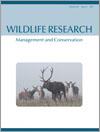Context. Wild pigs are an invasive species linked to numerous negative impacts on natural and anthropogenic ecosystems in many regions of the world. Robust estimates of juvenile wild pig survival are needed to improve population dynamics models to facilitate management of this economically and ecologically important invasive species. Despite this critical knowledge gap, to date no successful known-fate study of wild piglet survival (<5 months of age) has been conducted, due to a lack of appropriate method for this species.
Aims. To aid in locating and tagging neonates, we piloted the use of vaginal implant transmitters (VITs) in adult wild pigs and evaluated average retention times of stud ear-tag transmitters, clip ear-tag transmitters, sutured and epoxied transmitters, harness transmitters, and surgically implanted transmitters to monitor known-fate survival of piglets.
Methods. We captured pregnant female pigs and implanted them with VITs. We tagged subsequently located neonates and piglets captured in traps with the aforementioned transmitters and monitored them to determine retention times and feasibility of each method.
Key results. VITs were effectively used to determine the location and time of wild pig parturition, allowing counting and tagging of neonate wild pigs. Stud ear-tag and abdominal implant transmitters were well retained by piglets weighing ≥3 kg, in contrast to the other tested transmitters.
Conclusions. Stud ear-tag and abdominal implant transmitters allowed known-fate monitoring of juvenile wild pigs, although, of these, stud ear-tag transmitters may be more practical as they do not require field surgery on piglets. Due to their relatively large size, the stud ear tag transmitters were infeasible for monitoring of true neonates (∼1 kg); however, this application method may be suitable for neonates upon development of lighter-weight transmitters. The other transmitter attachment methods we tested were ineffective for monitoring of piglet survival, due to poor retention of transmitters.
Implications. The techniques piloted in this study will facilitate research into the reproductive ecology of wild pigs and known-fate studies of piglet mortality to aid in population modelling and evaluation of cause-specific mortality and factors affecting survival of these often-invasive animals.





